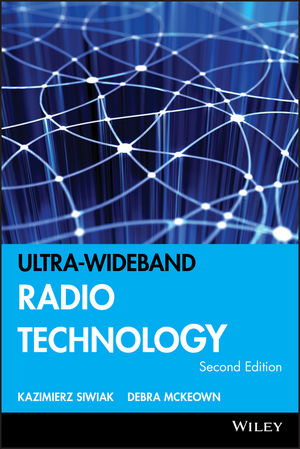Ultra-wideband Radio Technology, 2nd EditionISBN: 978-0-470-85931-5
Hardcover
264 pages
June 2004
 |
||||||
Dedication ix
Preface xi
Acknowledgements xvii
1 History 1
Introduction 1
1.1 The Basics of Radio 1
1.2 The History of Radio 6
1.3 About the Technology of the Time 14
1.4 Wireless Becomes Radio: The Era of Broadcasting and Regulations 14
1.5 Advantages in Wider Bandwidths 15
1.6 Radio Takes Another Wider-band Step 16
1.7 Still Wider has More Advantages 17
1.8 Summary 18
References 19
Further Reading 20
2 The Regulatory Climate 21
Introduction 21
2.1 Electromagnetic Spectrum: “Separation by Wavelength” 21
2.2 Radio Regulations 24
2.3 Adoption of UWB in the United States 27
2.4 Summary of First Report and Order 29
2.5 Regulations in Asia: The UFZ in Singapore 32
2.6 Regulation Activities in the European Union (EU) 34
2.7 Summary 35
References 37
3 UWB in Standards 39
Introduction 39
3.1 High Data Rate UWB Standards Activities in IEEE 40
3.1.1 An OFDM Approach to UWB 44
3.1.2 A DS-UWB Approach to UWB 45
3.1.3 A TD/FDMA Approach to UWB 48
3.2 Positioning and Location in UWB Standards 50
3.3 European Standards Efforts 50
3.4 Summary 52
References 52
4 Generating and Transmitting UWB Signals 55
Introduction 55
4.1 UWB Signal Definitions 58
4.2 Approaches to Generating UWB Signals 59
4.2.1 UWB Signal Design 60
4.2.2 Precision Signal Design 62
4.2.3 Calculating Power for Repetitively Sent Pulses 65
4.3 Signal Pulse Design Examples 68
4.3.1 Pulse Design Constraints 68
4.3.2 Choosing a Pulse Shape 69
4.4 UWB System Band Plans 72
4.5 Overlaying Precision Pulses 75
4.6 Signal Modulation 77
4.6.1 PPM Modulation 79
4.6.2 M-ary Bi-Orthogonal Keying Modulation 80
4.6.3 Pulse Polarity, BPSK, and QPSK Modulation 81
4.6.4 Pulse Amplitude Modulation 82
4.6.5 Transmitted Reference Modulation 83
4.7 Summary 86
References 86
5 Radiation of UWB Signals 89
Introduction 89
5.1 Short Pulse Radiation Process 90
5.1.1 The Far-field of an Arbitrary Antenna 92
5.1.2 The Far-field of an Ideal Infinitesimal Radiator 96
5.2 The Receiving Antenna 96
5.2.1 The Arbitrarily Shaped Receiving Antenna 97
5.2.2 The Infinitesimal Receiving Antenna 99
5.2.3 Transmission in Free Space Between Constant Gain Antennas 100
5.2.4 Transmission with a Constant Aperture Receiving Antenna 101
5.3 Transmitted, Radiated, and Received Signals 102
5.3.1 Simulations Using Wideband Signals 102
5.3.2 UWB at Moderate Bandwidths 106
5.4 Some Antenna Effects in UWB 107
5.4.1 The TE10 Mode Horn Antenna 108
5.4.2 The Dipole-fed Parabolic Reflector Antenna 109
5.4.3 Wideband Antenna Considerations 111
5.5 Summary 111
References 112
6 Propagation of UWB Signals 115
Introduction 115
6.1 Signal Propagation in Free Space 116
6.2 Propagation with a Ground Reflection 117
6.2.1 UWB and Time-harmonic Signals with a Ground Reflection 119
6.2.2 Design Example of a 2-GHz UWB Wide Signal 121
6.2.3 EIRP of the 2-GHz Bandwidth Pulse 124
6.2.4 Propagation of a 2-GHz-Wide UWB Signal Near the Ground 125
6.3 Propagation of UWB Impulses in Multipath 128
6.3.1 An Impulse Propagating through a Building 129
6.3.2 Multipath and Delay Spread 132
6.3.3 UWB Signals Propagating in Multipath 134
6.3.4 Relation to Maximum Rake Gain 139
6.3.5 The SBY Median Multipath Propagation Model 139
6.3.6 Shadowing Variation and Statistical Link Design 140
6.3.7 Propagation Models and Parameters 141
6.4 Summary 142
References 143
7 Receiving UWB Signals 147
Introduction 147
7.1 Reception of UWB Signals 148
7.2 Noise and Interference 149
7.3 Receiver-detector Efficiency 150
7.4 Efficiency of Simple Templates 154
7.5 The Self-correlating Receiver 156
7.6 Summary 156
References 157
8 UWB System Limits and Capacity 159
Introduction 159
8.1 Limits in Communications 160
8.1.1 Noise 160
8.1.2 Shannon’s Capacity Formula 161
8.1.3 Communication Efficiency of Various Modulations 163
8.1.4 Regulatory Limits 165
8.1.5 Antenna Apertures and Propagation 166
8.2 The UWB Fundamental Limit 168
8.2.1 Fundamental Limit for UWB 168
8.2.2 Fundamental Limit for Conventional Systems 172
8.3 UWB Wireless Links 173
8.3.1 UWB Link Budgets 173
8.3.2 Receiver Sensitivity and System Gain 175
8.3.3 Advantage of UWB in Non-AWGN Channels 176
8.4 Link Capacity 178
8.4.1 A UWB Link in Multipath 179
8.4.2 A Capacity Model for UWB 180
8.4.3 Capacity Model for IEEE 802.11a 182
8.4.4 Capacity Model for IEEE 802.11b 183
8.4.5 Comparing UWB with the 802s 184
8.5 Summary 185
References 186
9 Applications and Future Directions 189
Introduction 189
9.1 A Time Line of Wireless 190
9.2 UWB Applications 192
9.2.1 Communications and Sensors 193
9.2.2 Position Location and Tracking 197
9.2.3 Radar 199
9.3 UWB Over Wires 199
9.4 Summary 200
References 201
Appendix A Excerpts from the FCC First Report and Order 203
I. Introduction 203
II. Executive Summary 204
FCC 02–48 Appendix D – Changes to the Regulations 207
Subpart F – Ultra-Wideband Operation 209
Appendix B Summary of Multipath Model for IEEE P802.15.3a 225
Channel Characteristics Desired to Model 227
References 230
Appendix C Free-space Transmission of Pulses 231
Pulse Equations and Pulse Energy 231
Energy Density and Antenna Pattern 233
The Friis Transmission Formula with Constant-gain Antennas 234
Constant-aperture Receive Antenna 234
References 236
Appendix D Glossary 237
Definitions and Constants 237
Index 241



